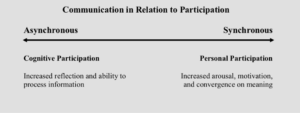Hello and welcome to my new and improved Topic 3 blog post! Before you begin reading, please watch my brief description to get a sense of how I dove further into this topic and gained more insight about equitable learning for all K-12 students.
I had trouble finding a way to make it clear what parts of my blog have been edited and revamped but in the end I decided to BOLD my changes. Additionally, I have added hyperlinks to outside resources that helped me complete this blog. Here we go:
How can you ensure equitable access to authentic, meaningful & relevant learning environments for all learners in K-12 open and distributed learning contexts? What did you already know, what do you know now based on the course readings and activities, what do you hope to learn?
If students all learn differently, shouldn't we give them a choice in how they represent this learning?
Here's 1st iteration of my Show What You Know choice board made for Ts & Ss. Stay tuned for links to innovation tutorialshttps://t.co/JGjkfsaWzf #distancelearning #TsGiveTs pic.twitter.com/mPwZX79VY4
— Christine Dixon (@christinekdixon) July 21, 2020
I found this visual provocation on Twitter the other day and it inspired me to dive into Topic 3-Equity and Access in Distributed and Online Learning Environments. How great is this visual for both teachers and students? There is a great variety of digital tools listed that are easily accessible to all students. I love that there are also options that do not require wifi or a device; this ensures all students can participate without worrying about digital access issues.
After reading Basham et al. (2020) speak about the diversity of our learners and how we can help them best succeed in this environment I was able to see how the Universal Design for Learning(UDL) framework is an extremely important resource for all educators teaching in distributed classrooms, and in physical classrooms as well. UDL provides a framework that encourages Multiple Means of Engagement, Action and Representation (Basham et al., p. 483).
Here is an example of a UDL Checkpoint that encourages voice and choice:

Research shows that students perform better and are happier when they are provided with voice and choice.
I found a handful of educators that are advocates for providing students with voice and choice for all students:
The one and only Shelley Moore
Twitter is filled with educators that are advocating for what they are most passionate about. It can be overwhelming at first, but by using specific hashtags and following along Twitter threads you can easily find educators that align with your personal pedagogy.
I have never heard of Kral and Schrab’s 8 design principles until today but they really made me think about how I will set up my future classroom. The Design Principles are as follows:
“Design Principle 1: A space young people control
Design Principle 2: A space for hanging out and ‘mucking around’
Design Principle 3: A space where learners learn
Design Principle 4: A space to grow into new roles and responsibilities
Design Principle 5: A space to practice oral and written language
Design Principle 6: A space to express self and cultural identity through multimodal forms
Design Principle 7: A space to develop and engage in enterprise
Design Principle 8: A space to engage with the world” (Kral & Schrab, 2012, p. 58).
Design Principle 1 made me think about online classroom blogs, or assignments that require students to learn from each other, rather than learning from the teacher. Online classrooms provide an array of activities that young people can control!
Design Principle 5 is another example that can be easily implemented in a blended learning setting. Personally, I used to think that online learning only allowed opportunities for students to practice their written language. However, there are many tools and programs that students can use to practice oral language online as well; ultimately, this also contributes to creating equitable learning environments where all students can succeed.
Kate prompted me to share more about how I think these Design Principles could be implemented into the classroom. To start, Design Principle 2 could be implemented into a classroom by providing opportunities for trial and error. Students learn better, and have more fun, when they can experiment and play around until they figure it out for themselves so as educators we must encourage them to learn through play!
Selwyn(2020) spoke about the effects that the COVID-19 pandemic and how it has affected students; he refers to this online learning as “emergency measures” (para. 5). It is no surprise that many businesses and online programs have been working hard to meet the needs of our schools; however, I was surprised to learn that it has created a type of pandemic education race to see who can create the most effective tools. The article progresses to speak about access issues that have accompanied COVID-19 and I can totally relate. For example, I have been participating in #edci339 while my Mom has also been working from home and joining Zoom calls all day. Luckily, we have our own laptops but we constantly run into internet issues with both of us using so much for our video calls. This has given me a new appreciation for the importance of asynchronous learning. If I ever get the chance to teach in a distributed classroom I will ensure to always offer an asynchronous option as well as a synchronous option so that all students have the chance to join in. Even something as simple as when Verena videotaped the Zoom meeting with the guest speakers could be beneficial to students who do not always have access to the internet because then they can watch it on their own time but still be a part of the community. Students usually share their devices with siblings and parents and will run into similar issues that my Mom and I did. Luckily, through this blog post and through my choice board activities I have gained a great sense of empathy towards accessibility issues. This will help me provide my students with meaningful experiences through distributed learning.
Asynchronous and synchronous learning environments are a hot topic right now! What one is better for our students as we approach September and the potential to revert back to online distance learning due to COVID-19? Through my research and readings, I have learned there is no right answer; students need a balance.

These screenshots were retrieved from: https://oit.utk.edu/wp-content/uploads/handout_synch_asynch.pdf

Ultimately, our students are so diverse and we need to provide them with learning oppurtunities that work for them. By following the UDL Guidelines that suggest providing Multiple Means of Engagement, Action and Representation we are able to personalize and differentiate learning. When it comes to a Distributed learning setting, teachers have the option to use synchronous and asynchronous communications. Teachers need to be mindful of students’ abilities and accessibility situations in order to create class plans (or backup options) so everyone can join in.
References
Basham, J.D., Blackorby, J., Stahl, S. & Zhang, L. (2018) Universal Design for Learning Because Students are (the) Variable. In R. Ferdig & K. Kennedy (Eds.), Handbook of research on K-12 online and blended learning (pp. 477-507). Pittsburgh, PA: Carnegie Mellon University ETC Press.
CAST (2018). Optimize Individual Choice and Autonomy. Universal Design for Learning Guidelines version 2.2. Retrieved from http://udlguidelines.cast.org/engagement/recruiting-interest/choice-autonomy
Kral, I. & Schwab, R.G. (2012). Chapter 4: Design Principles for Indigenous Learning Spaces. Safe Learning Spaces. Youth, Literacy and New Media in Remote Indigenous Australia. ANU Press. http://doi.org/10.22459/LS.08.2012 Retrieved from: http://press-files.anu.edu.au/downloads/press/p197731/pdf/ch041.pdf
Office of Information Technology. (n.d).When, why, and how to use synchronous vs. asynchronous communication. Office of Information Technology. Retrieved from: https://oit.utk.edu/wp-content/uploads/handout_synch_asynch.pdf
Selwyn. N. (2020). Online learning: Rethinking teachers’ ‘digital competence’ in light of COVID-19.[Weblog]. Retrieved from: https://lens.monash.edu/@education/2020/04/30/1380217/online-learning-rethinking-teachers-digital-competence-in-light-

Leave a Reply
You must be logged in to post a comment.